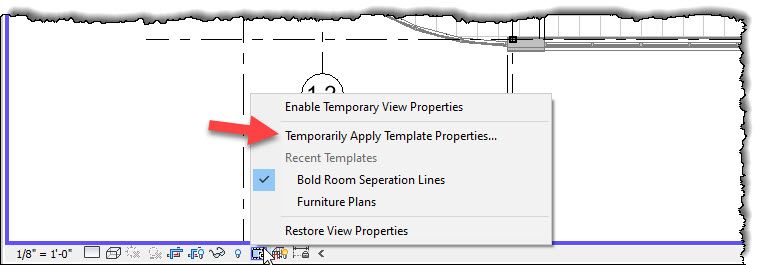Are you familiar with Revit’s temporary view properties? Using this, instead of changing the view template, can prevent a lot of problems! Keep reading to learn more!
The Challenge
You are in a Revit view and need to momentarily see something not visible in the view, such as furniture. You cannot just type VV and toggle it on for a second as there is a View Template applied, sop everything is grayed out there.
Too often, the designer will toggle off the View Template, turn on the Furniture category, and then (hopefully) remember to re-apply the View Template. If they forget, that furniture could show up on the bid set or somewhere otherwise not desired!
The Solution
Each view in Revit has an override toggle (see image below) which allows temporary changes to the view without affecting other users and without the worry of forgetting to undo the changes, because they are “temporary.” Therefore, if you close Revit without toggling back to Restore View Properties (see image below) the view changes/toggle are not saved.
Here is a brief overview of the two temporary view properties options…
Enable Temporary View Properties
This is likely the most used of the two options. For the example mentioned above, i.e. needing to see the furniture momentarily, we can select Enable Temporary View Properties for the current view, go into VV/VG and simply turn on the Furniture category (things are no longer grayed out here). When finished, select Restore View Properties (see image above). If you forget to toggle this off, no worries… the next time you open the Revit project is will be reset.
Temporarily Apply Template Properties
Using this second option can open up a whole new world for your personal “work view” in Revit. Templates can get really cluttered with a ton of QA/QC views, when you really just need a View Template for each. In the example below, selecting Temporally Apply Template Properties… opens the View Template dialog, where you can select from the list. This view template is then applied to the view. Just like the previous option, these view changes will not “stick” if you close the project.
Also, check out how the “recent templates” are now listed (compare with initial state in image above). This facilitates quickly toggling between visibility states. In the example below, I have a View Template to make Revit’s room separation lines hard to miss! This can be done in a work view or in the primary architectural plan which is on a sheet.
There is even a safeguard if you try to print with an override applied as shown in the following image.
Conclusion
This simple tip can open up a whole new world of model exploration and quality control… all without the fear of messing up an important printed deliverable!
You must be a registered user to add a comment. If you've already registered, sign in. Otherwise, register and sign in.










